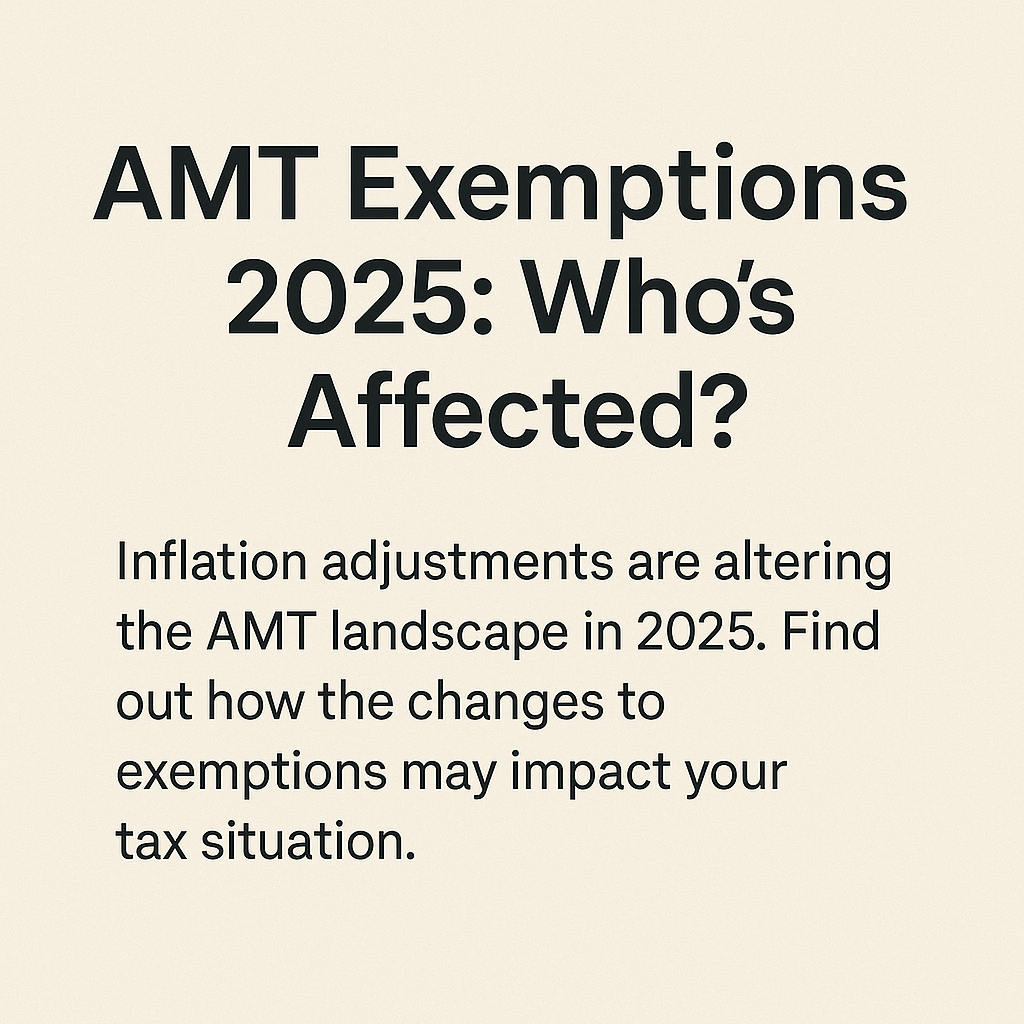
Inflation adjustments are changing who is affected by the AMT in 2025.
AMT 2025 Exemption Changes: Who’s Affected as Exemptions Shift
Alternative Minimum Tax (AMT) exposure is shifting again in tax year 2025 due to inflation adjustments. If you’re a higher‑income filer—or you expect a large year‑end event like stock option exercises or capital gains—now is the time to project your AMT position. For payment planning alongside AMT modeling, see our companion guide on estimated tax payments for high‑income individuals.
Quick refresher: how the AMT works
The AMT is a parallel tax system meant to limit how much certain tax preferences can reduce your total tax. You calculate tax twice:
- Regular tax under the ordinary rules.
- AMT, which starts with your regular taxable income, adjusts for specific preference items to compute alternative minimum taxable income (AMTI), subtracts an AMT exemption (if you qualify), then applies 26%/28% AMT rates. You owe whichever number is higher.
Authoritative background and definitions: IRS — About Form 6251, Alternative Minimum Tax (Individuals).
2025 AMT exemption amounts and phase‑outs
The IRS annually indexes the exemption and the income levels at which it phases out. For tax year 2025 (returns filed in 2026), the inflation‑adjusted figures are:
| Filing status | 2025 AMT exemption | Phase‑out begins (AMTI) |
|---|---|---|
| Single / Head of Household | $88,100 | $626,350 |
| Married Filing Jointly / QSS | $137,000 | $1,252,700 |
| Married Filing Separately | $68,650 | $626,350 |
Source: IRS tax year 2025 inflation adjustments (IR‑2024‑273). The exemption phases out at 25 cents per dollar of AMTI above the listed thresholds until it is fully eliminated.
Who is most likely to be pulled into AMT in 2025?
- High earners in high‑tax states who would otherwise claim large state and local tax (SALT) deductions (note: SALT interacts with AMT computations).
- Taxpayers exercising incentive stock options (ISOs) and holding the shares past year‑end (the ISO “bargain element” can increase AMTI).
- Filers with substantial long‑term capital gains or qualified dividends stacked on top of high ordinary income.
- Households with significant preference items or adjustments that are treated differently for AMT than for regular tax.
Common AMT triggers and why they matter
1) Incentive stock options (ISOs)
Exercising and holding ISOs can create AMTI equal to the spread between fair market value at exercise and the strike price. Even if your regular tax looks modest after capital‑gain planning, the ISO adjustment can create an AMT bill.
2) Large investment income years
Stacked capital gains and qualified dividends can push your AMTI above the phase‑out thresholds, eroding the exemption and increasing the chance that 26%/28% AMT rates will drive your final liability.
3) Deductions treated unfavorably under AMT
Certain deductions allowed (or partially allowed) for regular tax are limited or disallowed for AMT, which can increase AMTI relative to regular taxable income.
Planning strategies: reduce surprises before December 31
AMT outcomes are highly sensitive to timing. Before year‑end, model the following:
- Stage income events: If you control the timing of bonuses, RSU settlements, or sales of appreciated assets, consider splitting across tax years to keep AMTI below phase‑out bands.
- ISO strategy: Break exercises into tranches, target smaller spreads, and monitor AMTI in volatile markets. A same‑year disqualifying disposition may reduce AMT exposure—understand the ordinary‑income trade‑off.
- Harvest gains/losses intentionally: Coordinating capital gains with capital losses can help manage AMTI while preserving your broader investment plan.
- Coordinate charitable planning: Donor‑advised funds or appreciated stock gifts can lower regular taxable income; ensure the AMT interaction still helps your net liability.
- Run a fall projection: Use professional software or work with a tax pro to calculate both your regular and AMT positions under multiple scenarios.
Worked example (illustrative)
Maya (single) expects $420,000 of wages, $60,000 of long‑term gains, and plans to exercise ISOs with a $90,000 spread. Her AMTI after adjustments likely exceeds the $626,350 phase‑out threshold once the ISO spread is included, eroding the $88,100 exemption and pushing her toward AMT. If she instead exercises half the ISOs this year and half next year—while pairing year‑end loss harvesting—she can keep AMTI below the threshold in both years, preserving most of the exemption and reducing total tax over the two‑year window.
Withholding vs. estimated tax: cash‑flowing AMT
If your projection shows AMT liability, confirm that your withholding and/or quarterly estimated payments are sufficient to satisfy safe‑harbor rules and avoid penalties. Our detailed payment guide explains thresholds, vouchers, and scheduling for higher‑income filers: Estimated Tax Payments for High‑Income Individuals: What You Need to Know in 2025.
FAQs for 2025 AMT
Are AMT rates changing?
No. The AMT rate structure remains 26% and 28%. What changes annually are the exemption and the phase‑out thresholds via inflation adjustment. See the IRS overview here: About Form 6251.
Do capital gains get taxed differently under AMT?
Preferential capital‑gain rates generally still apply when calculating AMT if they are lower than the AMT rates. However, the gains increase AMTI, which can reduce your exemption. Modeling matters.
What if my exemption fully phases out?
If your AMTI is high enough, your exemption can be reduced to zero. At that point, you are effectively calculating AMT on your full AMTI base (after AMT preferences and adjustments), which often results in an AMT bill unless your regular tax is even higher.
Authoritative resources
Disclaimer
The information provided in this blog post is for informational purposes only and should not be construed as legal, tax, or accounting advice. Tax situations are often complex and highly specific to the individual or business. You should contact a qualified tax expert directly to discuss your particular circumstances. Nothing herein is intended to, nor does it, create an attorney-client or advisor-client relationship. For individual guidance, please contact us directly.


